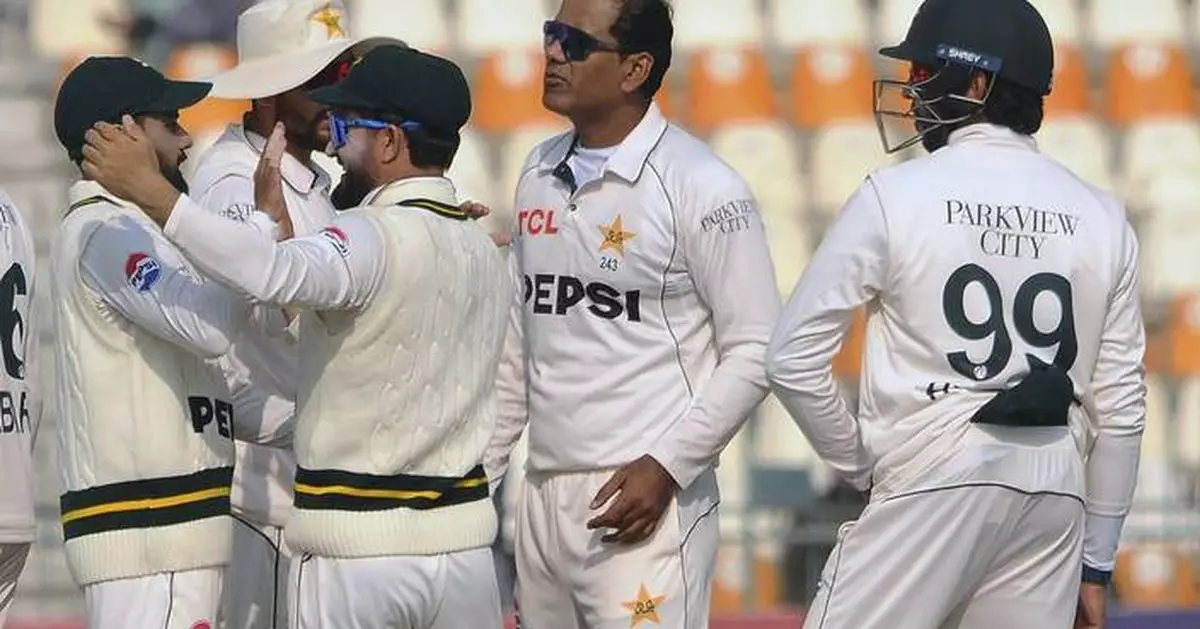MULTAN, Pakistan (AP) — West Indies collapsed to 137 all out within one session against Pakistan spinners Noman Ali and Sajid Khan as 19 wickets fell on Day 2 of the first test Saturday.
Pakistan, which got bowled out for 230 in the first innings on a turning wicket, stretched its lead to 202 and reached 109-3 with spinners claiming 17 of the 19 wickets to fall in a day.
Captain Shan Masood (52) raised his 11th test half-century off 60 balls and gave Pakistan a clear advantage before he got run out late in the final session with Kamran Ghulam not out on 9.
Left-armer Ali grabbed 5-39 and off-spinner Khan baffled the top four batters with 4-65 in the middle session on the same pitch where the spin duo had picked up all 20 England wickets in a test match last October.
Captain Kraigg Brathwaite (11) was the only among the top seven batters to breach the double figures as Khan and Ali bowled all but 14 deliveries before West Indies’ innings folded in 25.2 overs.
West Indies was in disarray at 91-9, but an aggressive counterattacking partnership of 46 runs off 21 balls between Jomel Warrican (31 not out) and Jayden Seales (22) took the visitors beyond the 100-run mark.
It was the second-lowest test innings, in terms of balls, against Pakistan, which bowled out Sri Lanka for 73 in 24.5 overs at Kandy in 2006.
West Indies top-order batters had no clue how to combat the sharp turning deliveries of Khan, who grabbed four wickets in space of his first three overs with the new ball.
Khan dismissed Mikyle Louis and Keacy Carty off successive deliveries with the latter brilliantly snapped up in the slips by debutant Mohammad Hurraira.
Khan then had Brathwaite clean bowled after the West Indies skipper went for an ambitious sweep against another sharp spinning delivery and Alick Athanaze offered a low return catch to the off-spinner as the tourists slipped to 22-4 in the fifth over.
Ali then got into the act and edged Khan for a five-wicket haul when he clean bowled Gudakesh Motie (19) off an inside edge as West Indies got bowled out before tea.
Earlier, West Indies spinners also profited from favorable conditions to bowl out Pakistan at stroke of lunch after the home team resumed on 143-4.
Left-arm spinner Warrican picked up 3-69 and Kevin Sinclair (2-61) accounted for the vital wickets of Saud Shakeel (84) and Mohammad Rizwan (71) as Pakistan lost last six wickets for 43 runs.
Shakeel and Rizwan had extended their fifth-wicket stand to 141 before Pakistan lost wickets in cluster in the latter half of first session.
On a wicket tailor-made for spinners, Shakeel and Rizwan had dominated the three West Indian spinners before Sinclair broke the threatening stand soon after the first drinks break when he found the outside edge of left-handed Shakeel’s bat.
Shakeel hit six boundaries in his 157-ball knock and had revived Pakistan innings with Rizwan after the home team had slipped to 46-4 against fast bowler Seales’ (3-27) triple strike on Day 1.
Pakistan then lost three more wickets in space of 10 deliveries and slipped to 200-8 as the spinners extracted sharp turn with the odd ball getting low.
Rizwan, who hit nine fours in just over three hours stay at the wicket, missed the line of Sinclair’s full pitched delivery while going for an extravagant reverse sweep and was out leg before wicket.
Khan (18) and Khurram Shahzad (7) shared second best partnership of the innings when they contributed 25 runs for the ninth-wicket stand before Warrican wrapped up the innings just before lunch by removing both batters in his successive overs.
Pakistan is at No. 8 and West Indies is at No. 9 on the WTC points table after performing under-par over the last one year in tests. Australia and South Africa have already qualified for June 11-15 WTC final at Lord’s.
AP cricket: https://apnews.com/hub/cricket

Pakistan's Saud Shakeel, center, plays a shot during the day two of the first test cricket match between Pakistan and West Indies, in Multan, Pakistan, Saturday, Jan. 18, 2025. (AP Photo/Asim Tanveer)

West Indies Jomel Warrican, center, celebrates with teammates after taking the wicket of Pakistan's Salman Ali Agha during the day two of the first test cricket match between Pakistan and West Indies, in Multan, Pakistan, Saturday, Jan. 18, 2025. (AP Photo/Asim Tanveer)

West Indies Jomel Warrican, right, bowls as Pakistan's Saud Shakeel watches during the day two of the first test cricket match between Pakistan and West Indies, in Multan, Pakistan, Saturday, Jan. 18, 2025. (AP Photo/Asim Tanveer)

Pakistan's Said Khan, center, celebrates with teammates after taking the wicket of West Indies Mikyle Louis during the day two of the first Test cricket match between Pakistan and West Indies, in Multan, Pakistan, Saturday, Jan. 18, 2025. (AP Photo/Asim Tanveer)

Pakistan's Noman Ali, center, celebrates with teammates after taking the wicket of West Indies Kevin Sinclair during the day two of the first Test cricket match between Pakistan and West Indies, in Multan, Pakistan, Saturday, Jan. 18, 2025. (AP Photo/Asim Tanveer)















